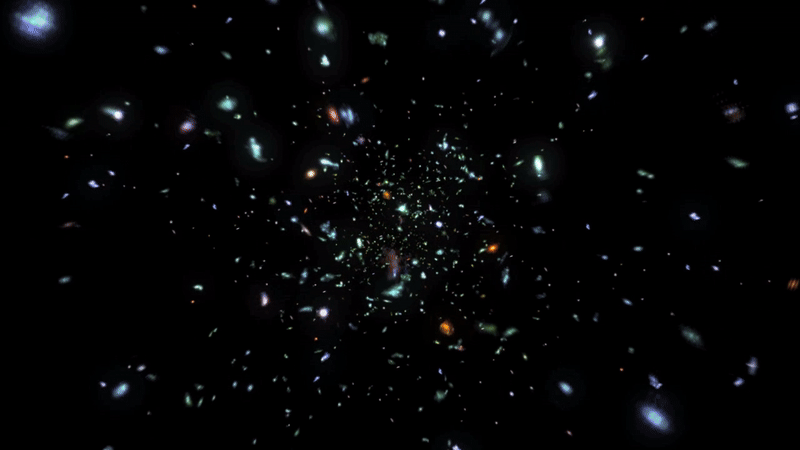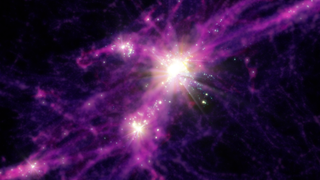The cosmic dark ages: Everything you need to know
The first hydrogen to form absorbed light from the first stars in the universe. Eventually, the universe filled up with stars and galaxies that reionized this hydrogen, allowing photons to travel freely in all directions.

The "cosmic dark ages" refers to a period during the early universe when sources of light were cloaked in a dense fog of neutral hydrogen gas. While light can now travel in all directions across the universe, rendering it transparent, the early universe was shrouded in hydrogen, which absorbed the light emitted by the first stars and sources of radiation.
For the first 380,000 years after the Big Bang, all matter and energy existed as an extremely hot, dense expanding ball of ionized plasma. At this point, collisions between subatomic particles in this high-energy soup prevented the particles from acquiring electrons to form stable atoms. Once the universe had sufficiently expanded and cooled, however, subatomic particles could acquire electrons to form neutral hydrogen atoms, and the cosmic dark ages began.
Related: James Webb Space Telescope reveals how galaxies made the early universe transparent
However, once enough stars were born, the ultraviolet light they produced eventually ionized all of the hydrogen in interstellar space, allowing photons to travel freely in all directions across the universe, without being absorbed or scattered by neutral hydrogen. Through a combination of simulations and observations, astrophysicists have estimated that the cosmic dark ages began 380,000 years after the Big Bang. The processes that are thought to have brought the cosmic dark ages to an end started roughly 680 million years after the Big Bang and ended approximately 1.1 billion years after the Big Bang.
Cosmic dark ages FAQs
How long did the cosmic dark ages last?
While it is generally accepted that the cosmic dark ages began 380,000 years after the Big Bang when the first neutral hydrogen atoms formed, exactly when this period ended is still a matter of debate. The processes of reionization, in which massive early stars in the universe sent ultraviolet light out into the cosmos, likely took several million years as more and more stars emerged from the cosmic darkness. Observations of early galaxies have suggested the onset of ionization began roughly 680 million years after the Big Bang, while the complete ionization of the visible universe was likely completed around 1.1 billion years after the Big Bang.
What is the dark age of the universe?
The phrase "dark ages of the universe" refers to a phase of the early universe when it was blanketed in darkness. In the early universe, ultraviolet light could not freely travel long distances, as it was absorbed and scattered by dense clouds of neutral hydrogen atoms.
What caused the cosmic dark ages to end?
The end of the cosmic dark ages was a gradual process. Denser regions of neutral hydrogen gas in the early universe eventually gravitationally collapsed to form massive stars — the first stars in the universe. These stars sent large amounts of ultraviolet light into the nearby universe, but it wasn't until stars and protogalaxies were abundant in the early universe that enough ultraviolet light was emitted into space so as to completely reionize all of the neutral hydrogen in interstellar space.
The emergence of hydrogen
The onset of the cosmic dark ages was ushered in by the emergence of hydrogen in the universe. The Big Bang was hot. But once the dense plasma of protons, electrons and other subatomic particles were given enough space to cool due to the expansion of the universe, these electrons and protons could come together to form atoms, in the form of lots of hydrogen and a little helium.
Although the galactic abundance of hydrogen eventually seeded the first stars and galaxies, this primordial hydrogen's absorption of different frequencies of light on the electromagnetic spectrum left the adolescent universe opaque.
However, once the fusion furnaces of the first stars and galaxies became widespread across the universe, enough high-energy ultraviolet radiation — photons — were emitted into interstellar space to strip neutral hydrogen atoms of their electrons. Now, rather than being absorbed by these electron-carrying hydrogen atoms, these high-energy photons became free to travel vast distances across the universe.
The first stars and galaxies

Astronomers estimate the first stars and galaxies started to emerge in the universe during the first 500 million years of cosmic history. These early stellar populations were responsible for distributing the first heavy elements across the cosmos and for triggering the reionization process that allowed light to travel unimpeded across space.
The Near Infrared Camera on the James Webb Space Telescope has provided astronomers with unprecedented access to observe these structures in the early universe, and it has turned up a few surprises. Observations of these early galaxies show them to be significantly more luminous than galaxy formation models had predicted. One explanation is that these early galaxies were populated with extremely large, swelteringly hot stars.
Peering back into the cosmic dark ages
Our ability to make observations of the universe as it existed during the cosmic dark ages is limited by a couple of obvious barriers. For one, it was dark, and sources of light were obstructed by the dense clouds of hydrogen from that time. However, astronomers and cosmologists think we might one day be able to observe some light from this period in the early universe — namely, radio waves emitted by hydrogen gas.
Radio waves of this magnitude could only be observed from space, as Earth's atmosphere blocks them out. However, someday, a moon-based observatory could look back to a time when the universe looked significantly different from how it does now. Astronomers have shown that a moon-based radio observatory could offer a tantalizing glimpse at the cosmic dark ages.
Additional resources
Read more about the role of hydrogen in the universe with this Nature article. Learn more about the first stars and reionization era with this NASA infographic. If you want to find out more about the cosmic dark ages check out this informative YouTube video from PBS Space Time.
Bibliography
Bosman, S., et al. Monthly Notices of the Royal Astronomical Society, Volume 514, Issue 1, July 2022, Pages 55–76, https://doi.org/10.1093/mnras/stac1046
Grochala, W. First there was hydrogen. Nature Chemistry, 7, 264 (2015). https://doi.org/10.1038/nchem.2186
Mondal, R., Barkana, R. Prospects for precision cosmology with the 21 cm signal from the dark ages. Nat Astron 7, 1025–1030 (2023). https://doi.org/10.1038/s41550-023-02057-y
Tilvi, V., et al. The Astrophysical Journal Letters, Volume 891, Number 1, February 2020, https://doi.org/10.3847/2041-8213/ab75ec
Join our Space Forums to keep talking space on the latest missions, night sky and more! And if you have a news tip, correction or comment, let us know at: community@space.com.
Get the Space.com Newsletter
Breaking space news, the latest updates on rocket launches, skywatching events and more!

Conor Feehly is a New Zealand-based science writer. He has earned a master's in science communication from the University of Otago, Dunedin. His writing has appeared in Cosmos Magazine, Discover Magazine and ScienceAlert. His writing largely covers topics relating to neuroscience and psychology, although he also enjoys writing about a number of scientific subjects ranging from astrophysics to archaeology.
-
rod Space.com reported, "While it is generally accepted that the cosmic dark ages began 380,000 years after the Big Bang when the first neutral hydrogen atoms formed, exactly when this period ended is still a matter of debate."Reply
Cosmology calculators can show the z number or range here if used.
Example, https://lambda.gsfc.nasa.gov/toolbox/calculators.html
This calculator suggest z ~ 1100 or so when the Universe is only about 370-380,000 years old. At redshift about 6, Universe age close to 1 Gyr. Seems there is a large redshift range where Population III stars and hydrogen gas filling the early Universe with no metals should be visible today. So far, nothing confirmed here it appears.
